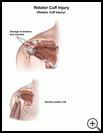
Rotator Cuff Injury
________________________________________________________________________
KEY POINTS
- A rotator cuff injury is damage to the muscles and strong bands of tissue that support your shoulder when you move it.
- Change or stop doing the activities that cause pain until the injury heals.
- A rotator cuff injury can be treated with exercise, ice, moist heat, and sometimes with medicine or surgery.
________________________________________________________________________
What is a rotator cuff injury?
A rotator cuff injury is irritation of or damage to the group of tendons and muscles that hold your shoulder joint together. Tendons are strong bands of tissue that attach muscle to bone. You use the muscles and tendons in your shoulder joint to move your shoulder and raise your arm over your head.
What is the cause?
A rotator cuff injury can be caused by:
- Overuse of your shoulder in a sport or work activity that involves repetitive overhead movement of your shoulder, like swimming, baseball (mainly pitching), football, tennis, painting, plastering, or housework.
- A sudden activity that twists your shoulder or tears your tendon, such as using your arm to break a fall, falling onto your arm, or lifting a heavy object
You may be at higher risk for a rotator cuff injury if you have poor head and shoulder posture, especially if you are older.
What are the symptoms?
Symptoms may include:
- Pain and weakness in your arm and shoulder
- Trouble moving the shoulder, especially when you try to raise your arm overhead
- Swelling and bruising around the shoulder
How is it diagnosed?
Your healthcare provider will ask about your symptoms, activities, and medical history and examine you. You may have X-rays or other scans or procedures, such as:
- An ultrasound, which uses sound waves to show pictures of your shoulder joint
- An MRI, which uses a strong magnetic field and radio waves to show detailed pictures of your shoulder joint
- An arthrogram, which is an X-ray or MRI taken after a dye is injected into your joint to outline its shape
- Arthroscopy, which is a type of surgery done with a small scope inserted into your joint so your provider can look directly at your joint
How is it treated?
You will need to change or stop doing the activities that cause pain until your injury has healed. For example, avoid strenuous activity or any overhead motion that causes pain. Also, try to make sure that you are practicing good posture and are not slouching forward.
Your healthcare provider may recommend stretching and strengthening exercises to help you heal.
If you keep having pain, your provider may give you a shot of a steroid medicine.
If you have a bad tear, you may need to have it repaired with surgery. After surgery, your treatment plan will include physical therapy to strengthen your shoulder as it heals.
The pain often gets better within a few weeks with self-care, but some injuries may take several months or longer to heal. It’s important to follow all of your healthcare provider’s instructions.
How can I take care of myself?
To keep swelling down and help relieve pain:
- Put an ice pack, gel pack, or package of frozen vegetables wrapped in a cloth on the area every 3 to 4 hours for up to 20 minutes at a time.
- Take nonprescription pain medicine, such as acetaminophen, ibuprofen, or naproxen. Read the label and take as directed. Unless recommended by your healthcare provider, you should not take these medicines for more than 10 days.
- Nonsteroidal anti-inflammatory medicines (NSAIDs), such as ibuprofen, naproxen, and aspirin, may cause stomach bleeding and other problems. These risks increase with age.
- Acetaminophen may cause liver damage or other problems. Unless recommended by your provider, don't take more than 3000 milligrams (mg) in 24 hours. To make sure you don’t take too much, check other medicines you take to see if they also contain acetaminophen. Ask your provider if you need to avoid drinking alcohol while taking this medicine.
- Put moist heat on the sore area for 10 to 15 minutes before you do warm-up and stretching exercises. Moist heat may help relax your muscles. Moist heat includes heat patches or moist heating pads that you can buy at most drugstores, a warm wet washcloth, or a hot shower. To prevent burns to your skin, follow directions on the package and do not lie on any type of hot pad. Don’t use heat if you have swelling.
Follow your healthcare provider's instructions, including any exercises recommended by your provider. Ask your provider:
- How and when you will get your test results
- How long it will take to recover
- If there are activities you should avoid, including how much you can lift, and when you can return to your normal activities
- How to take care of yourself at home
- What symptoms or problems you should watch for and what to do if you have them
Make sure you know when you should come back for a checkup. Keep all appointments for provider visits or tests.
How can I help prevent a rotator cuff injury?
Warm-up exercises and stretching before activities can help prevent injuries. For example, do exercises that strengthen your shoulder muscles. If your arm or shoulder hurts after exercise, putting ice on it may help keep it from getting injured.
Follow safety rules and use any protective equipment recommended for your work or sport.
Avoid activities that cause pain. For example, avoid lifting heavy objects over your head.

